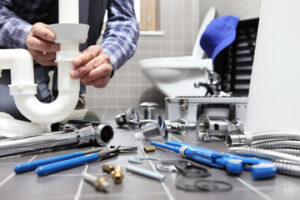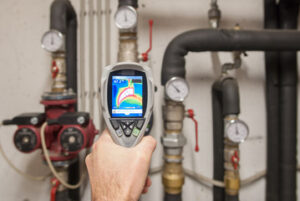Plumber The Woodlands is a hands-on, physically demanding trade that requires focus and determination. Plumbers install, maintain and repair a wide range of plumbing systems in homes and businesses. Their duties include laying pipes, connecting taps and toilets, and power-flushing heating systems.

In new construction, they work from blueprints and architectural plans to design and lay the pipe infrastructure. They also have to be able to adhere to building codes and regulations.
A plumber’s job is to install, repair, and maintain plumbing systems in homes and businesses. They may install new plumbing in a construction project, or they might fix old pipes and fixtures that aren’t working properly. Plumbers use a variety of tools to perform their duties, and they must be familiar with local codes and regulations. Most states require plumbers to be licensed. Getting certified requires passing an exam and meeting experience and education requirements. Many plumbers learn their trade through an apprenticeship, which combines classroom instruction with paid on-the-job training. Some vocational schools and community colleges offer certificate programs in plumbing.
When installing new plumbing, a plumber must follow blueprints and architectural plans to design the system’s layout. They also need to estimate the cost of materials and labor before beginning work. If they are fixing existing plumbing, they must remove the old pipes and fixtures and replace them with new ones. Plumbers often work in construction sites alongside other tradespeople, such as carpenters and electricians.
Residential plumbers install and repair a wide range of plumbing fixtures, including toilets, faucets, sinks, showers, tubs, and water heaters. They also inspect heating and cooling systems to ensure they are functioning properly. Other responsibilities include repairing or replacing broken toilets, bathtubs, and showers; removing garbage disposals; and resolving issues with sewer lines and septic tanks. Licensed residential plumbers are also qualified to handle gas line installation and repairs.
Commercial plumbers work on larger-scale plumbing projects, such as office buildings, schools, hospitals, and shopping centers. They often need to install plumbing in new construction and ensure that the building meets code requirements before it is occupied. These plumbers also have the skills to work on industrial plumbing systems, which are more complicated than household plumbing.
Because they frequently interact with clients, plumbers need excellent customer service skills. They must be able to explain complex plumbing problems in simple terms and answer questions clearly. They also need to be reliable and punctual when arriving at a client’s home or business. Plumbers must also be willing to travel to different locations to complete their work.
Repair
In addition to installing new plumbing fixtures, appliances, and pipes, plumbers also repair existing ones. This is a vital part of their job, as it ensures that all components are working correctly and prevents water damage to the home. Leaky pipes, clogged drains, and other problems can be quite dangerous if not addressed promptly, so it’s important to have a reliable plumber on call.
Leaky pipes are one of the most common plumbing issues that homeowners face. These leaks can lead to significant water bills and property damage if not addressed quickly. A plumber will usually implement a temporary solution, such as a pipe repair sleeve, to cover the leak until they can come back to permanently fix it.
Plumbers use a variety of tools to perform plumbing repairs, including pipe cutters, wrenches, and power tools. They may also need to use non-destructive techniques, such as bursting or re-caulking, to repair pipes without damaging the surrounding materials. Plumbers are also skilled at using camera inspection tools to identify the source of a problem and develop an effective plan for repair.
Most plumbing systems have multiple drainage pipes that carry waste and excess water away from sinks, tubs, and showers. When these pipes become clogged, it can cause flooding, water damage, and health issues for the home’s occupants. A plumber will remove the clog and clean the drain line with high-powered equipment to restore the flow of water.
Another common plumbing repair involves the home’s water filtration system. If a homeowner notices that the water pressure is lower or the filtered water taste different, it’s time to call a plumber for a system diagnosis and repair. Plumbers can install or replace water filters, test the water pressure to determine whether a filter is necessary, and perform other maintenance tasks related to the water filtration system.
While many plumbing repairs are simple for a skilled plumber to complete, some projects are more complex and require specialized equipment or training. For example, plumbers who work on sewage systems must be knowledgeable about the potential dangers of human waste, which contains infectious microbes like cholera, typhoid, and hepatitis. These bacteria are excreted through the faeces and vomit of the sufferer, and can infect others through contact with water or contaminated surfaces.
Maintenance
Plumbing systems take away waste water, provide hot and cold water, and regulate indoor climate through pipes, valves, and fixtures. Plumbers install and repair these systems, as well as perform regular maintenance to keep them functioning properly. This includes cleaning drains, repairing toilets and sinks, and replacing water heaters. Plumbers also have to deal with emergency calls, such as burst pipes or sewage backups.
Plumbing is a trade that requires extensive on-the-job training and certification. The path to becoming a plumber starts with an educational program or training academy, followed by an apprenticeship under a master plumber. After gaining some experience, apprentices can apply to become a licensed plumber. The process varies by state and municipality, but usually involves passing an exam and meeting education and experience requirements.
While working, plumbers must follow strict health and safety guidelines to protect themselves and their clients from exposure to infectious diseases. This includes wearing protective clothing and gear, such as rubber gloves and face masks, when handling raw sewage or other hazardous materials. Plumbers may also need to work with electricity, so it’s important that they follow the appropriate electrical safety precautions.
Plumbers must have strong customer service skills to interact with their clients and explain complex issues. This involves listening to a client’s concerns and explaining the problem in a way that is easy for them to understand. It also involves providing advice and recommendations on how to fix the issue.
Depending on the industry, plumbers may have to collaborate with other professionals, such as construction teams or architects. This is especially true for commercial plumbers, who often work on larger-scale plumbing systems in office buildings, restaurants, or factories. In these settings, the plumbing systems are typically more complex and have to be installed according to specific building codes.
A plumber’s work is often physically demanding and requires stamina. They must be able to lift heavy objects and stand for extended periods of time while installing or repairing pipes. Additionally, they must be able to maneuver tools and work in tight spaces. Plumbers are also required to wear gloves and safety goggles when handling certain hazardous materials, such as fecal matter or vomit from patients in hospitals or care homes.
Customer Service
Plumbers must be able to communicate with customers and explain technical issues in easy-to-understand terms. They also need to provide accurate estimates for repair work and be respectful of their clients’ properties. Finally, plumbers often work with construction teams and architects to ensure plumbing systems are seamlessly integrated into building projects.
Service and repair plumbers respond to calls from home and business owners to address plumbing problems like leaks, clogs, and broken fixtures. They use their technical training and experience working with common plumbing systems to troubleshoot issues on site and perform repairs to restore functionality. Service and repair plumbers must be personable, as they interact with customers more frequently than other types of plumbers.
Construction plumbers are responsible for installing plumbing systems in new buildings. This involves laying pipes, connecting fixtures, and ensuring all systems comply with local building codes. Construction plumbers must be able to read blueprints and understand how all the pieces of a plumbing system fit together. They also need to be able to recognize when a piece of pipe or fixture is defective or damaged and know how to replace it with the proper part.
Inspectors oversee the work of plumbers and ensure all regulations are met. They may also be responsible for testing water quality and identifying issues with waste disposal systems. Inspectors must be able to use specialized equipment like video cameras to inspect pipes and test pressure levels, as well as identify any violations of plumbing codes. Additionally, inspectors may be required to attend meetings with construction teams or homeowners to discuss plumbing concerns. While not necessary for plumbers, earning professional certifications can help them stand out in the job market and show dedication to the trade. Plumbers who want to improve their skills and qualifications can pursue certifications in areas like green plumbing practices, water heater installation, or advanced plumbing techniques.
